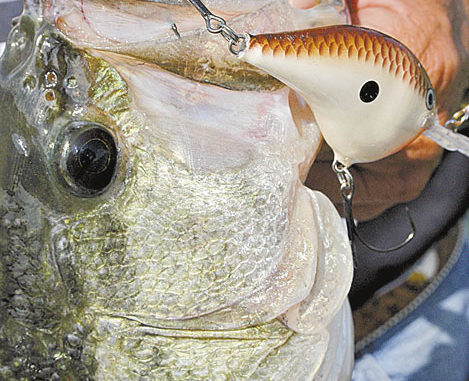
It can be really confusing when you walk into a tackle shop and look at the rows and rows of crankbaits, all different sizes and styles and colors.
How does a weekend fishermen figure out what he needs to have in his tackle box?
The easiest way to start is by discussing colors. It wouldn’t surprise me to know that there are hundreds of different color combinations on the shelves, and being able to narrow that down a little bit can certainly save a bass fishermen a good bit of money, as well as pointing him in the right direction as far as when you use a chartreuse, a crawfish or a shad-colored bait.
To start with, there are a few colors that can be good anytime you go fishing, and those are pearl/gray shad and hot mustard, which is a combination of crawdad, brown and sunfish. Shad colors can be good at any given time and on any given lake, because shad is probably the baitfish that bass feed on the most. But seasonal changes in what bass are eating or what the water looks like can bring other colors out.
In most reservoirs in North Carolina, bass are in the peak of the spawn in early May. By the end of the month, they’ll be coming off the beds, recovering from the spawn and getting ready to feed up again, so this is naturally a good place to start.
During the postspawn, I like to fish shad colors, bluegill colors and the old reliable, pearl/gray shad. You have bluegill trying to eat the eggs and fry immediately after bass spawn and for several weeks thereafter, so the bluegill color is great. Also, you start to get some bluegill spawning, and bass that have recovered from the spawn will gang up around bluegill beds to feed. You also get your chartreuse/browns starting to come in.
There is a difference between postspawn and summer colors. From about mid-July on, your chartreuse baits really start to come in, your chartreuse/green — the bait we call “homer” — chartreuse/blue, parrot (chartreuse/blue/green) and Clark Gable (chartreuse/green stripes) colors. On some lakes, certain colors really work during the summer. You get on some of the Tennessee River lakes, and it’s blue. At Buggs Island, blue can be good, and so can green or pearl/gray shad.
I think the reason chartreuse comes into play in the summer is that bass are feeding more on bluegill than shad, and because they’re in deeper water and those chartreuses show up better.
In the fall, my favorite color is brown/bone, which we used to call “carp.” There’s something about that color that really works when the water starts to get that “milky” color when a lake gets ready to turn over. The bass will really get on that color. If you look at that brown/shad or brown/bone color, if you stick it down in cloudy water and look at it, it looks just like a shad; the brown sort of goes away. Brown/bone is a perfect color once a lake gets ready to turn over.
When we get into the winter, shad colors are going to be dominant. Any crankbait with a shad or pearl finish will be good, and a lot of times a solid pearl or chrome will be great, especially with a black back.
As the spring approaches, I’ll fish pearl/gray shad, but I also like to fish crawfish colors. Anything with a shade of brown or red or gold can be a good spring color. Bluegill is mostly a postspawn and early summer color, but in the spring, if you’re fishing really clear water, bluegill can be a good color.
So a fisherman looking to fill a tackle box with crankbaits can cut down on the number of color combinations he needs by sticking with eight or 10 basic colors. You can match the colors you buy with baits that run to certain depths depending on the season you expect to be fishing. Bluegill might be a great color in a Rapala DT-6 or DT-10. You need pearl/gray shad and hot mustard in all sizes. You can expect to fish chartreuse baits more often in deep-diving models like a DT-16.
Knowing a handful of colors that you’ll likely need will help you key in on what models and colors you need to have in your tackle box.
David Fritts is a 54-year-old pro bass fisherman from Lexington. He won the 1993 Bassmasters Classic champion and the 1997 FLW Tour Championship, and he was the 1994 BASS Angler of the Year. He is sponsored by Ranger boats, Evinrude outboards, Rapala, VMC hooks, Zoom, American RodSmiths and Bass Pro Shops.




Be the first to comment